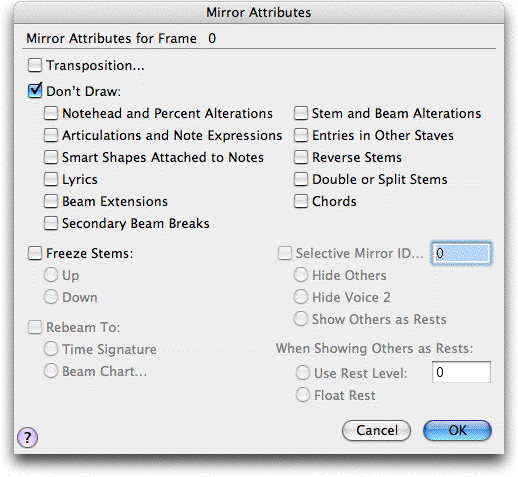

Or,
Or,
A mirror is an intelligent copy of an existing (or "source") measure in the score. When you edit the source measure in any way, all mirrors created from it are instantly updated to reflect the change. In this dialog box, you can specify certain ways in which you want the mirror to differ from the source measure. For example, you could specify that it be transposed up an octave (if, say, it’s doubling another instrument in the score). You can also specify stem direction, beaming, and whether or not you want various other elements (lyrics, chord symbols, and so on) to appear in the copy.
The advantage of all this control is that you can link the mirror to the source music, but the original and the copy need not be utterly identical. You copy only those elements you want to copy.
|
Checkbox Name |
Musical elements affected |
|
Notehead and Percentage Alterations |
Changes to the note shape or size you’ve made with the Special Tools tool or the Resize tool |
|
Articulations and Expressions |
Note-attached marks created with the Articulation tool or the Expression tool |
|
Slurs Attached to Notes |
Note-attached slurs that start and end in the affected region. |
|
Lyrics |
Lyrics of any type |
|
Beam Extensions |
Extended beams created with the Special Tools Tool |
|
Secondary Beam Breaks |
Breaks in the beams of sixteenth notes (and smaller values) created with the Special Tools tool |
|
Stem and Beam Alterations |
Modifications to stem length and shape, or to beam angles, created with the Special Tools tool |
|
Entries in Other Staves |
Cross-staff notes (refers not to the notes themselves, but whether their cross-staff status should be preserved) |
|
Reverse Stems |
Reverse stemming created with the Special Tools Tool |
|
Double or Split Stems |
Double or split stemming created with the Special Tools tool |
|
Chords |
Chord symbols |
For this purpose, Finale offers you the ability to choose individual notes from a mirror or composite mirror; the result is a selective mirror. To create one, click the words Selective Mirror ID; Finale displays the Selective Mirror dialog box.
In this graphic window, you can click the handles of the notes you want include in the selective mirror. You can pick individual notes out of a chord or, by drag-enclosing several handles, you can select groups of notes within chords. If the selective mirror omits notes that fall on certain beats (when you choose only the first and third quarter notes of a melody, for example), Finale will provide rests in place of the omitted notes.
Click Prev and Next to scroll through other selective mirrors you’ve created from the main mirror. When you’re finished, click OK; Finale automatically enters the number of the selective mirror in the text box. See Selective Mirror dialog box.
See Also:
| User Manual Home |

|